
.'d
said to be wholesome [Simmonds]. Insects preying on the foliage
of this tree are poisoned by it. I t will bear the frosts of Norway
to lat. 61° 17' [Schuebeler],
Gynocardia odorata, R. Brown.
From Burma to Sikkim and Khasia, ascending to 3,000 feet. A
tree to 50 feet liigh. Seeds large, the oil of which has come into
medicinal use as cliaulmugra-oil [Christy].
Gyrophora esoulenta, Miyoshi.
The “ Iw a ta k e ” of Japan. This Lichen grows there chiefly on
moist granitic rocks, and is extensively used for human nutriment,
and in this respect incomparable with any other Lichen, unless
perhaps Cetraria Islándica. The plant is sold in a dried state. I t
would be worthy of naturalisation, as it does not take up any space
otherwise to be utilised ; it is not bitter nor has it any purgative
action, but is quite palatable ; contains much starchy and gelatinous
substance [Dr. Mambii Miyoshi].
Hæmatoxylon Campechianum, Linné.
From Soiith-Mexico to Venezuela. A tree, attaining 40 feet in
height. Flourishes still a t a considerable distance from the tropics,
thus for instance a t Moreton-Bay. I t yields the Campeche-wood or
logwood for dyes and inks, and for a cliemical reagent, the latter
depending on the principle Hæmatoxylin. A good black ink is
obtained by boiling 1 lb. of logwood in 1 gallon of water down to g
gallon strained fluid, to which are to be added 3 ounces of chrome-
alum, I ounce dextrin, and 15 drops of Creosote [Berliner Apotheker
Zeitung, 1894, p. 134].
Hagenia Abyssinica, Willdenow. (Brayera anthdmintica, Kunth.)
Abyssinia, a t elevations from 3,000 to 8,000 feet. A tall tree,
admitted in this list, because its flowers have come into medicinal
use as an anthelmintic. I t is moreover quite eligible for ornamental
plantations.
Hamamelis Virginica, Linné.
Eastern States of North-America. The “ Witch-Hazel.” A
shrub or small tree. The leaves are renowned in the States for
medioinal properties ; the seeds are oily and edible.
Hancomia speciosa, Gomes.
Brazil, to far southern regions, on sandy plains. This small tree
naay prove hardy in extra-tropio regions free of frost. The good-
sized berries are of very pleasant taste, and vernacularly known as
Mangadlas. Most valuable is the very elastic rubber of this plant.
Mr. Thomas Christie regards it as superior to Para-Rubber, and
worth a t present 3s. per lb.
Hardwicicia binata, Roxburgh.
India, up to elevations of nearly 4,000 feet. Maximum-height of
tree 120 feet. Wood from red-brown to nearly black, olose-gramed,
exceedingly hard, heavy and durable ; valued for under-ground
work. The bark furnishes easily a valuable material for cordage.
The tree ean readily be pollarded for cattle-fodder [Brandis].
Harpephyllum Caffrum, Bernhardi.
The Kaffir Plum-tree. South-Africa. A large spreading evergreen
tree, the fruit of which makes a fair preserve ; the timber is
used for furniture and waggon-work. Sometimes planted a t midsummer
as fencing poles, each of which grows and forms a shelter-
helt round fields [T . R. Sim].
H a r p u l l i a H i l l i i , P- v. Mueller.
The Tulip-Wood of Queensland. One of the most important of
the numerous kinds of trees indigenous there for select cabinet-work.
H. pendula (IRanehon) is equally valuable.
Hedeoma pulegioides, Persoon.
The Penny-royal of Eastern North-America. An annual herb
of aromatic taste, employed in medicine. The volatile oil is also
in use.
Hederá Helix, Fuchs.
The Ivy. Europe, Northern Africa, Western Asia as far as the
Himalayas. Not to be omitted here, as it quickly forms evergreen
walls over all kinds of fences and on sides of buildings without
iniiirinu any sound masonry ; it is also a bee-plant.^ Ivdividual
plants 'w ill live through several centuries. A particular Iv y at
Montpellier is now 440 years old. One of the readily available and
most effectual of plants for surrounding and concealing with its
twio-s any tubs, boxes, pots and other articles at hortioultural shows.
The variety with yellow-marked leaves is singularly ornamental.
Resists the smoky air of cities [Loudon]. Hedenc acid is of
medicinal value. A decoction of the leaves dyes hair black.
Hedysarum coronarium, Linné.*
The Soola- or Sulla-Clover. Soutliern Europe, Northern Africa.
One of the best of perennial fodder-herhs, yielding a bulky return.
I t is also reeommendable as quite a handsome garden-plant and as a
honey-plant, the Maltese honey owing its superior flavor mamly to
this plant. The plant likes lime in the soil. Mons. Scribeaiix
recommends stirring the seeds for some few minutes in hot water
before sowing, whereby the germination is much facilitated.